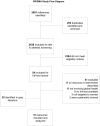A Scoping Review on Resources, Tools, and Programs to Support Women's Leadership in Global Health: What Is Available, What Works, and How Do We Know?
- PMID: 37091314
- PMCID: PMC10120609
- DOI: 10.5334/aogh.3921
A Scoping Review on Resources, Tools, and Programs to Support Women's Leadership in Global Health: What Is Available, What Works, and How Do We Know?
Abstract
Background: The unequal representation of women in global health leadership is a prevalent issue laterally across global health fields and vertically down experience levels. Although women compose much of the workforce, gender-based barriers prevent female talent from filling their appropriate leadership roles, which funnels unique expertise and problem-solving skills on a diversity of health topics out of positions of leadership. Currently, many calls to action have been proposed to raise awareness of the lack of women's global health leadership, with Women in Global Health as one of the more prominent movements. This paper evaluates how the priorities and strategies for leadership training and development set forth by such movements have changed the landscape of available programs and resources for women in global health, based on availability, success, and evaluation.
Objectives: This manuscript maps existing programs and resources that support women's leadership in global health and describes available evaluations and documented outcomes.
Methods: We used a dual approach of a peer-reviewed and gray literature search to build a comprehensive list of existing programs and resources designed to support women's leadership in global health. Out of 54 items included for full-text review and 22 gray literature items screened for inclusion, a total of 31 resources were processed in the final extraction. We used descriptive quantitative analysis for categorical and binary variables, while qualitative data from evaluations were analyzed for outcomes.
Findings: Resources were in the form of conferences, supplemental resources to conferences, certificate programs, coursework, stand-alone documents, single-focus programs, and mostly multicomponent programs. Most resources did not have a global health focus area, and a third of the total resources identified women first authors from predominantly high-income countries. About half of the resources mention mentorship and networking as activities incorporated as part of the resource. Over half of the resources did not have a target audience, and most resources were free to users.While there is a lack of consistent and meaningful evaluation of the resources, the available captured metrics of success were described as the number of career-advancing opportunities after using the resources. Examples of opportunities include enrollment in graduate school, receiving academic promotions, participating in internships, presenting at conferences, and publications.
Conclusion: While the supply of existing programming and resources to advance women's leadership in the global health field is limited in terms of quantity, it is rich in diverse formats, content, and implementation. This scoping review supports the notion that empowered female leadership in global health requires a complementary support system that encourages the unique needs and talents of female leaders. Such a support system needs inclusive targeting regardless of experience level, academic degree, or location. Furthermore, evaluations of resources will be critical in maintaining meaningful interventions that effectively dismantle the infrastructures that continue to limit the success of women leaders in global health.
Keywords: global health; training; women’s leadership.
Copyright: © 2023 The Author(s).
Conflict of interest statement
The authors have no competing interests to declare.
Similar articles
-
Strategies to Improve Women's Leadership Preparation for Early Career Global Health Professionals: Suggestions from Two Working Groups.Ann Glob Health. 2022 Jul 11;88(1):53. doi: 10.5334/aogh.3705. eCollection 2022. Ann Glob Health. 2022. PMID: 35891882 Free PMC article.
-
Gender equality in the 21st century: Overcoming barriers to women's leadership in global health.J Dent Educ. 2022 Sep;86(9):1144-1173. doi: 10.1002/jdd.13059. J Dent Educ. 2022. PMID: 36165260 Review.
-
Beyond the black stump: rapid reviews of health research issues affecting regional, rural and remote Australia.Med J Aust. 2020 Dec;213 Suppl 11:S3-S32.e1. doi: 10.5694/mja2.50881. Med J Aust. 2020. PMID: 33314144
-
A scoping review on the impact of women's global leadership: evidence to inform health leadership.BMJ Glob Health. 2025 Feb 4;10(2):e015982. doi: 10.1136/bmjgh-2024-015982. BMJ Glob Health. 2025. PMID: 39904721
-
Pathways to leadership: what accounts for women's (in)equitable career paths in the health sectors in India and Kenya? A scoping review.BMJ Glob Health. 2024 Jul 17;9(7):e014745. doi: 10.1136/bmjgh-2023-014745. BMJ Glob Health. 2024. PMID: 39019545 Free PMC article.
References
-
- Global Health 50/50. The Global Health 50/50 Report: How Gender-Responsive Are the World’s Most Influential Global Health Organisations? London: Global Health 50/50; 2018. DOI: 10.5860/CHOICE.50-5845 - DOI
-
- World Health Organization. Delivered by Women, Led by Men: A Gender and Equity Analysis of the Global Health and Social Workforce. World Health Organization; 2019. Accessed December 11, 2021. https://apps.who.int/iris/bitstream/handle/10665/311322/9789241515467-en....
-
- AAMC. The State of Women in Academic Medicine. Accessed January 20, 2022. https://www.aamc.org/data-reports/faculty-institutions/report/state-wome....
Publication types
MeSH terms
LinkOut - more resources
Full Text Sources
Medical


